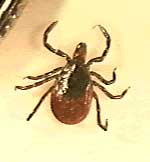By Erin Galbally
Minnesota Public Radio
December 6, 2001
The state's tick population has soared because of the warmest fall in more than 100 years. It's a phenomenon any deer hunter, particularly in southeastern Minnesota, knows well. Typically, ticks disappear for the winter before the start of hunting season. But this year, that's not the case. And it's prompting concerns that Lyme disease could be on the rise.
| |
|
|
|
||
During hunting season, freshly dressed deer hang from hooks in Larry Lawrence's shop. Lawrence processes venison in rural Stewartville. He's well known to hunters across southeastern Minnesota and parts of Wisconsin. This year he's seen deer pelts loaded with ticks. So after each shift in his garage workshop, Lawrence drops his clothes in a plastic bag and showers immediately. He checks himself carefully for ticks.
Next year he may scale back business, only accepting deer from certain areas. He'll lose money, but Lawrence says after this year's tick infestation he needs to put safety first.
"In past years, if I'd seen 100 in a season, that was something. If I've seen one I've seen 10,000 this year," says Lawrence. "I had deer with hundreds of them on. I dealt with this all season and it's scary,"
Particularly scary, because Lawrence suffers from debilitating joint pain and other symptoms that sound like Lyme disease. Generally, deer ticks avoid agricultural areas like Olmsted County. Instead they prefer wooded regions like the Mississippi River basin and forested sections of Wisconsin.
Three years ago Lawrence asked a doctor for his first Lyme test. He had to fight his doctor and insurance company for the test. He ultimately paid for it himself. This year, ticks even burrowed into the walls of his shop. Lawrence says, come January, he'll be tested for Lyme disease once again.
"I can feel them bite me most of the time, like mosquitoes will bite you. I'll feel it, and of course I'll know what it is," says Lawrence. "I had one bad situation this year that wasn't good. I know that it was a deer tick and I had all of that bruising."
| |
|
|
|
||
Lawrence says he's shown nearly all the signs of Lyme disease - and he's not alone. In Minnesota, Lyme Disease is on the rise. In 1999, the Department of Natural Resources reported close to 300 cases. By the following year, nearly 500 people tested positive for Lyme disease. Case numbers aren't in for this year.
Dave Neitzel, an epidemiologist for the state Department of Health, doubts the current situation will change Lyme disease statistics. He expects people will still report the majority of tick-borne illnesses in the late spring and summer.
"That's when the small nymph stage of the deer tick is active. We see about 80 percent to 85 percent of our cases occurring during that time. While people can be affected by Lyme in the fall, most people are able to locate ticks and remove them before Lyme disease takes place," says Neitzel.
It's not just the warm weather to thank for the healthy tick population. The deer population is way up in southeastern Minnesota and central Wisconsin. Brock Verville, a wildlife information specialist at the James Ford Bell Museum of Natural History in St. Paul, says more deer mean more hosts for parasites like ticks.
"In these past three out of four winters having warm weather, a lot of deer were probably having twin fawns," Verville says. "(That) has caused the population to explode, so much so that in Wisconsin they have actually increased the deer gun season from one season to three of them in order to control the population."
But Verville cautions it's naive to draw any long-term conclusions from this year's surge in the tick population. Ultimately, weather plays the most significant and unpredictable role. It's entirely possible that a hard winter or two could make the tick population - and even the deer population - drop substantially.
More Information

